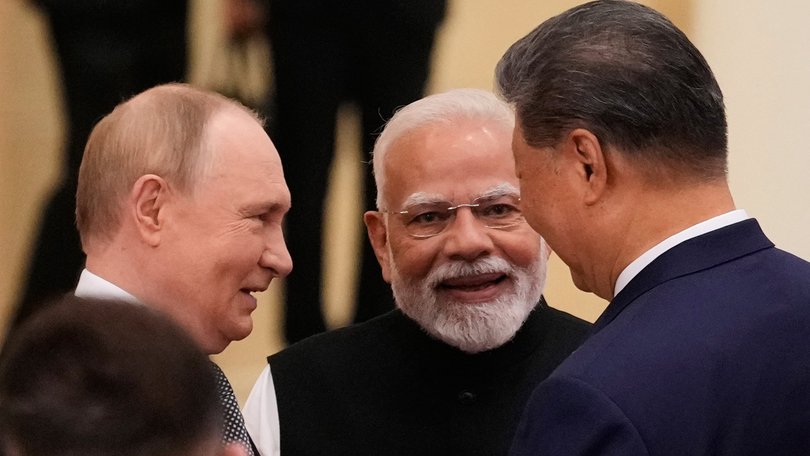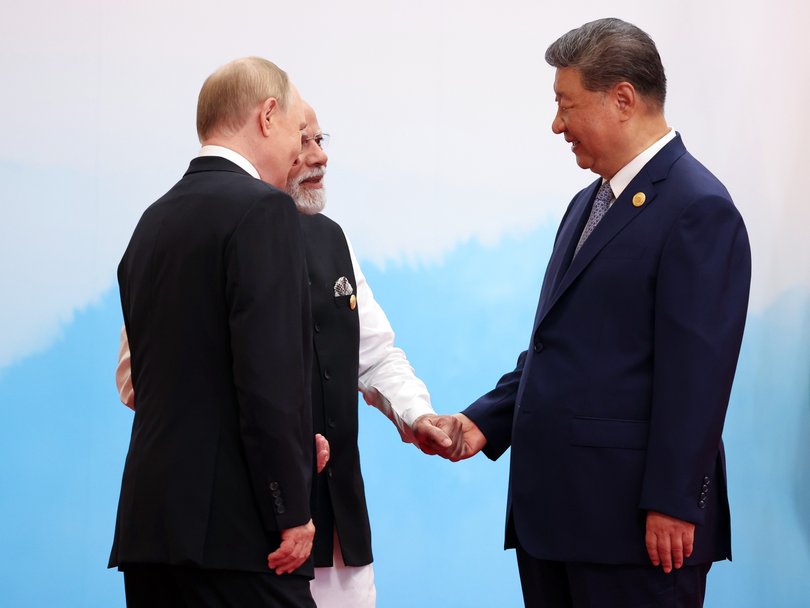Behind the smiles with Vladimir Putin, Narendra Modi and Xi Jinping at China summit

Sometimes one photograph tells the story better than any communique or summit declaration.
A widely shared clip of Chinese President Xi Jinping, Indian Prime Minister Narendra Modi and Russian President Vladimir Putin laughing together in Tianjin has already gone viral.
On the surface, it appears to be an easy exchange between three leaders. But analysts say it reflects a delicate mix of competing rivalries and shifting power dynamics.
Sign up to The Nightly's newsletters.
Get the first look at the digital newspaper, curated daily stories and breaking headlines delivered to your inbox.
By continuing you agree to our Terms and Privacy Policy.Gautam Bambawale, India’s former ambassador to China, told CNBC’s Inside India: “The dragon and the elephant are not dancing as yet.
They are just looking at each other from opposite sides of a room and trying to assess what are the implications of the relationship between the two? It’s going to take time to bring the relationship back on track.”
The obstacles are clear. The border dispute between India and China remains unresolved since the 2020 clashes.
Beijing’s close partnership with Pakistan — extending beyond economic corridors into military equipment and intelligence cooperation — further constrains how far ties can develop.
This week’s Shanghai Cooperation Organisation (SCO) summit gave the photograph its backdrop. The SCO is expanding in size and ambition, but as Jeremy Chan at Eurasia Group pointed out, more prominence does not necessarily mean more relevance.
“The SCO, while it’s generally described as a security organisation, really doesn’t focus on military matters per se, and on all of the global conflicts that have taken place recently, whether that’s Ukraine or in Gaza, the SCO has essentially been absent,” Mr Chan told CNBC.
The timing of the meeting is also notable. With US President Donald Trump raising tariffs and unsettling global markets, Beijing is using the SCO to emphasise its outreach to the Global South.
Mr Chan said Mr Trump is “breathing new life” into the summit, giving China a chance to frame its diplomacy as more dependable than Washington’s.
On Monday, Mr Trump posted on Truth Social, saying that India had offered to reduce its tariffs to U.S. goods to zero. Describing the relationship with India as one-sided, Mr Trump said the US is India’s biggest client.
“The reason is that India has charged us, until now, such high Tariffs, the most of any country, that our businesses are unable to sell into India. It has been a totally one sided disaster! Also, India buys most of its oil and military products from Russia, very little from the US. They have now offered to cut their Tariffs to nothing, but it’s getting late. They should have done so years ago,” Mr Trump posted.
Meanwhile, the photo-op has also drawn scrutiny in US media.
The New York Times described the interaction as a “smiling manifestation of a troika that Moscow had recently said it hoped to revive,” noting the optics of closeness between Mr Modi and Mr Putin, who even shared a ride to a meeting on the sidelines.
The report argued that India’s traditionally cautious bureaucracy might once have avoided such overt displays with China and Russia, but Mr Trump’s sweeping tariffs leave New Delhi with “little incentive” to hold back.
Multipolarity, defined differently
For investors, the stakes are significant. The SCO brings together economies representing nearly half the world’s population, central to energy and trade flows.
With tariffs threatening supply chains and markets watching for signs of fragmentation, summits like these are closely watched for signals of new alignments, even if substantive outcomes are limited.
For India, the optics carry weight. Mr Modi’s talks with Mr Xi were interpreted as a reminder to Washington that India is willing to maintain dialogue with Beijing and Moscow while deepening ties with the US and its allies.

But New Delhi’s decision to skip the SCO military parade underscored the limits of any thaw.
“India is using this to opportunistically send a signal indirectly to Washington, that it has strategic options, not only in Beijing, but also in Moscow,” Mr Chan said.
Mr Modi’s quick exit from the summit, immediately after arriving from Tokyo, also underlined India’s continued engagement with US partners in Asia.
At the heart of the summit was a debate over “multipolarity,” Mr Chan said, adding that the definition of multipolarity is different for India and China.
Beijing defines it as a system where US dominance is reduced, allowing China greater scope to assert itself as Asia’s leading power. India, by contrast, sees multipolarity as influence spread more evenly across many countries, with no single state in control, Mr Chan told CNBC’s Inside India.
Meanwhile, for Russia, the SCO remains one of the few international platforms where Putin is not on the defensive, underscoring Moscow’s enduring ties with influential Asian partners despite Western sanctions.
The photograph captures all of this in a single frame. The smiles suggest harmony, but the reality is far more complex.
